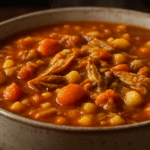Latest Articles

A conversation about Christmas plans turned into an unexpected journey into the history of wassail — a drink once shared by orchard keepers, carolers, and families gathered on Twelfth Night. What began as curiosity became a rediscovery of an almost forgotten holiday ritual.

For generations, black-eyed peas and greens have carried more than flavor to New Year’s Day tables—they’ve carried hope. Rooted in history and strengthened by family tradition, this humble meal has become a quiet ritual of resilience, prosperity, and new beginnings.

Discover how Christmas dinner varies across America—from New England seafood feasts to Southwest tamales—in this nostalgic look at regional traditions.

Over the centuries, eggnog has traveled a long road from its European beginnings to its place on American holiday tables. Its story is one of adaptation, abundance, and tradition, reflecting how a simple mixture of eggs, milk, and spirits became a symbol of seasonal cheer.

This year, an estimated 20 million American households will be serving Campbell’s classic green bean casserole as part of their Thanksgiving festivities.

In the 1940s through the ’60s, a trip to the grocery store wasn’t complete without a stop at the cold-cut case. Bologna, olive loaf, and liverwurst were more than sandwich fillings—they were part of the rhythm of everyday life.

Pinto bean pie, a uniquely Southern dessert that found a home in Appalachian cooking, is reminiscent of sweet potato or pumpkin pie.

Chicken and dumplings carries a history as rich as the broth it’s cooked in. From European kitchens to Southern farm tables, this humble yet celebratory dish has been simmering in American culture for generations.

Brunswick stew’s rich history blends folklore, regional pride, and a good dose of friendly rivalry over who made it first—proof that a bowl of stew can be as much about heritage as it is about flavor.

White potato pie has been a cherished Maryland dessert, particularly on the Eastern Shore, for generations.












